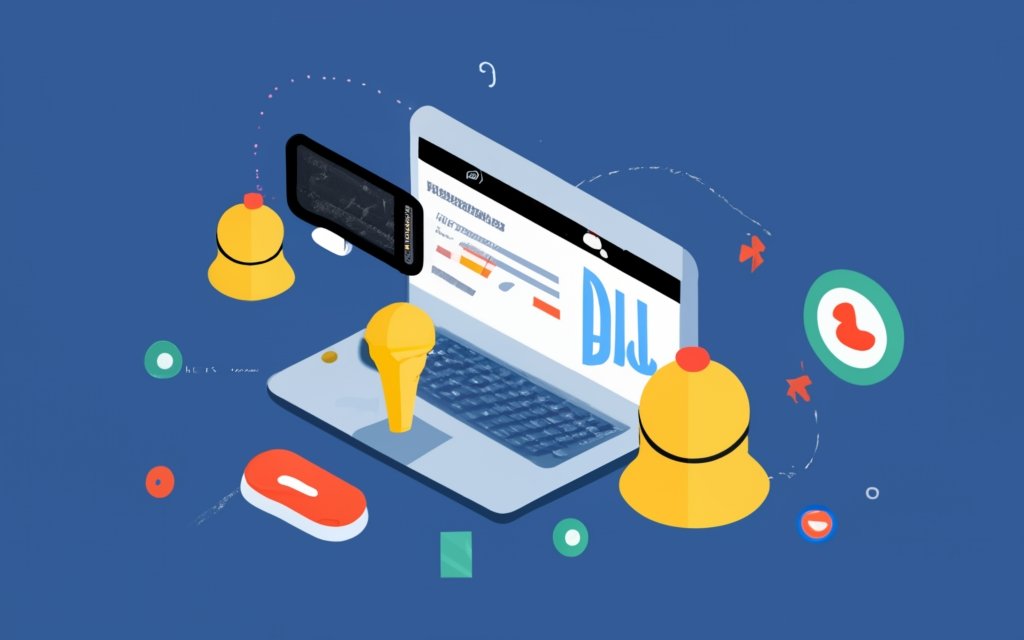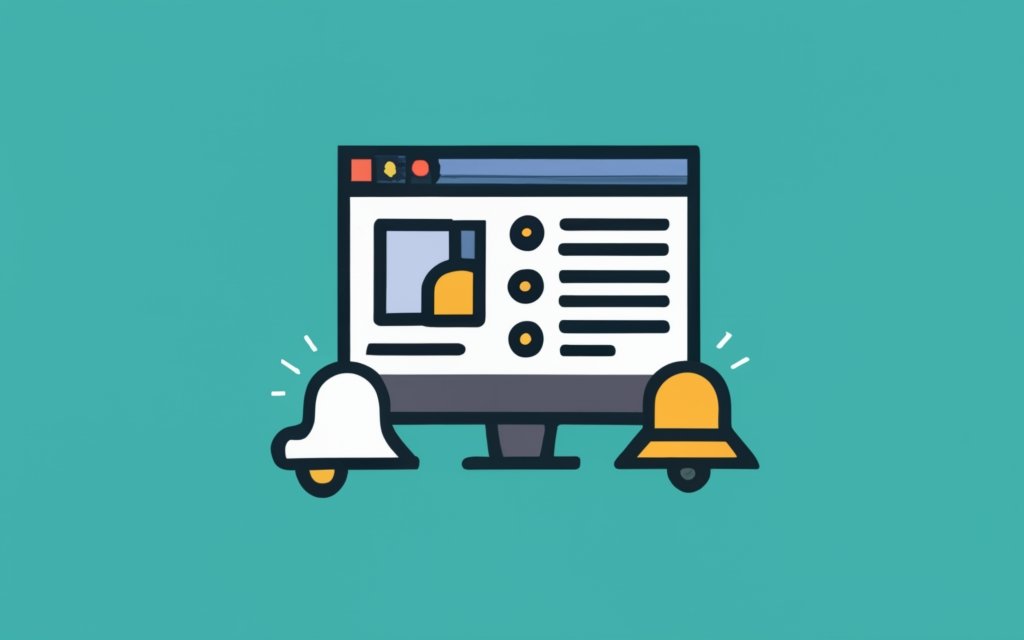Push notifications have become an integral part of website communication, allowing website owners to engage with their users in real-time. If you have a WordPress site, adding push notifications can provide several advantages and improve user engagement. This article will guide you through the process of adding push notifications to your WordPress site using plugins, outlining some popular options available.
But first, what exactly are push notifications? Push notifications are short messages that are sent to users’ devices, appearing as notifications even when they are not actively using the website. These messages can be used to deliver updates, promotions, reminders, or any other important information to your users.
Adding push notifications to your WordPress site offers several advantages. It allows you to deliver instant updates to users, increase site traffic, boost user engagement, and improve conversions.
To add push notifications to your WordPress site, you can utilize various plugins specifically designed for this purpose. These plugins offer different features, customization options, and integrations. In this article, we will explore three popular push notification plugins: Plugin A, Plugin B, and Plugin C.
Choosing the right push notification plugin for your WordPress site depends on specific factors such as your website’s requirements, target audience, budget, and desired functionalities. It’s important to carefully evaluate and compare different plugins before making a decision.
To help you get started, this article will provide a step-by-step guide on how to add push notifications to your WordPress site using a chosen plugin. It will cover installation and activation, plugin configuration and settings, customizing push notification design, and creating notification campaigns.
In addition, the article will offer tips for optimal usage of push notifications, ensuring that you leverage this feature effectively while respecting your users’ preferences. It will also address common issues and troubleshooting methods to help you resolve any potential challenges along the way.
By the end of this article, you will have a good understanding of push notifications, the available plugins for WordPress, and how to seamlessly integrate this powerful communication tool into your website. Let’s get started and enhance your WordPress site with push notifications!
Key takeaway:
- Adding push notifications to your WordPress site increases engagement: Push notifications enable you to reach your audience instantly, increasing user engagement and driving traffic to your site.
- Choosing the right push notification plugin is essential: Consider factors like compatibility, features, ease of use, and customization options when selecting a push notification plugin for your WordPress site.
- Optimize push notification campaigns for best results: Customize the design, carefully plan notification campaigns, and follow best practices to maximize the effectiveness of your push notifications.
What Are Push Notifications?

Photo Credits: Www.Uncleb.Tech by Jordan Scott
Push notifications are a valuable tool for website owners to engage with their audience and keep them informed. What Are Push Notifications? Here are some important facts:
- Push notifications are messages sent directly to users’ devices, such as smartphones or computers, even when they are not actively using the website or app.
- They can be used to send updates, promotions, reminders, or any relevant information to users.
- Push notifications can be customized to target specific segments of the audience based on preferences, behavior, or location.
- They have high visibility and can instantly grab users’ attention, increasing the chances of them taking action.
- Push notifications have proven to effectively drive user engagement, increase website traffic, and boost conversions.
You can easily incorporate push notifications into your WordPress site with the help of plugins like OneSignal, PushEngage, and PushAlert. These plugins offer various features and customization options to meet your specific needs. You can learn more about how to add push notifications to your WordPress site with plugins by visiting How to Add Push Notifications to Your WordPress Site with Plugins.
By implementing push notifications on your WordPress site, you can enhance user engagement, provide timely updates, and effectively communicate with your audience. Consider adding push notifications to your website today to improve your overall user experience and achieve your business goals.
Advantages of Adding Push Notifications to Your WordPress Site

Photo Credits: Www.Uncleb.Tech by Gerald Martin
Advantages of Adding Push Notifications to Your WordPress Site
Push notifications offer advantages for WordPress site owners:
1. Increased Engagement: Adding push notifications to your WordPress site allows you to reach your audience instantly. These notifications can grab users’ attention and increase their engagement with your site.
2. Boosted Traffic: Sending push notifications drives traffic back to your site. Whenever you publish new content or have important updates, push notifications can notify your subscribers and encourage them to visit your site, resulting in increased traffic.
3. Improved User Experience: Push notifications provide a convenient way for users to stay updated with your site. Whether it’s important announcements, special offers, or personalized content recommendations, push notifications enhance the overall user experience.
4. Higher Conversion Rates: Push notifications can improve conversion rates by delivering timely and relevant messages to users. For example, you can use push notifications to notify users about limited-time offers or abandoned cart reminders, encouraging them to take action and make a purchase.
5. Increased Subscriptions: Adding push notifications to your WordPress site can help you grow your subscriber base. By offering users the option to receive push notifications, you can capture their attention and encourage them to subscribe, allowing you to build a loyal audience.
6. Real-Time Communication: Push notifications enable real-time communication with your audience. You can instantly notify users about important updates, breaking news, or time-sensitive information.
7. Personalization: With push notifications, you can deliver personalized messages based on user preferences or behavior. By segmenting your audience and sending targeted notifications, you can provide a more personalized and tailored experience.
Understanding Push Notification Plugins
Looking to enhance user engagement on your WordPress site? Look no further! In this section, we’ll dive into the world of push notification plugins, exploring how they can revolutionize your website’s communication strategy. Whether you’re interested in Plugin A, Plugin B, or Plugin C, we’ll uncover the unique features and benefits that each plugin brings to the table. Get ready to take your WordPress site to the next level with captivating push notifications!
Plugin A
Plugin A is a customizable push notification plugin for WordPress. Users can create personalized and targeted push notification messages for their website. Plugin A allows users to schedule notifications based on specific times or user behavior. The plugin provides real-time analytics and reporting for users to track push notification campaign performance. Users can also customize the design of push notifications to match their website branding.
Fact: Marketing strategists have praised Plugin A for its user-friendly interface and robust features, making it popular among WordPress site owners.
Plugin B
Plugin B is crucial for adding push notifications to your WordPress site. It offers features to improve the effectiveness and efficiency of your notification campaigns.
Here is a table outlining the key features and advantages of
| Feature | Description |
|---|---|
| Automatic Notifications | Plugin B automatically delivers notifications to your website visitors. |
| Real-time Analytics | It provides real-time analytics to track the performance of your push notification campaigns. |
| A/B Testing | With Plugin B, you can conduct A/B testing to optimize your push notification messages and increase click-through rates. |
| Targeted Push Notifications | It enables you to target user segments with personalized push notification messages. |
| Scheduled Notifications | Plugin B lets you schedule notifications in advance for timely delivery to your audience. |
| Opt-in Customization | You can customize the opt-in process and subscription dialog box to align with your brand and increase opt-in rates. |
| User-friendly Interface | The plugin offers a user-friendly interface that is easy to navigate and configure according to your preferences. |
| Global Support | Plugin B provides global support, allowing you to implement push notifications regardless of your location. |
Plugin B is a valuable tool for any WordPress site that wants to utilize push notifications. It enhances your marketing strategies and engages your audience effectively.
Plugin C
Plugin C is a notable option for push notification plugins for WordPress sites. Key features and benefits include:
- Easy installation and integration with your WordPress site.
- Provides automatic notifications to keep users informed and engaged.
- Utilizes Google’s natural language processing (NLP) technology for improved message delivery and user experience.
- Offers global support, reaching your audience regardless of location.
- Customize opt-in forms to match your website’s design and style.
- Includes real-time analytics to track push notification performance.
- Optimize campaigns based on Google Trends and browser market share data.
With Plugin C, you can enhance website reach and increase user engagement through targeted push notifications. It is a reliable tool for delivering updates, boosting click-through rates, and reducing cart abandonment. Plugin C’s user-friendly interface and advanced features make it an excellent choice for WordPress site owners looking to leverage the power of push notifications.
Choosing the Right Push Notification Plugin for Your WordPress Site

Photo Credits: Www.Uncleb.Tech by Walter Walker
Choosing the perfect push notification plugin for your WordPress site is crucial for engaging your audience effectively. In this section, we’ll dive into the factors to consider when selecting a push notification plugin. From customization options to integration capabilities, we’ll explore the key elements that will help you make an informed decision. So, buckle up and get ready to elevate your website’s notification game to new heights!
Factors to Consider
When choosing a push notification plugin, there are several factors you should take into account. First, consider the cost and pricing plans of the plugin. It’s important to find a solution that fits within your budget.
Another factor to consider is the ability to send automatic notifications based on specific triggers. Look for a plugin that allows you to set up automated notifications that will be sent to your audience when certain conditions are met.
Global support is also important, especially if you have an international audience. Make sure the plugin offers global support and is compatible with different languages and regions.
Opt-in customization is another key factor. You should choose a plugin that allows you to customize the opt-in process, so you can tailor it to match your branding and the preferences of your audience.
Real-time analytics are crucial for tracking the performance of your push notifications. Consider if the plugin provides real-time analytics that can give you insights into delivery rates, open rates, and other important metrics.
User segmentation is another important feature to look for. Find a plugin that allows you to segment your users based on behavior or demographics. This will enable you to send more targeted and personalized notifications.
If you need to schedule notifications in advance, make sure the plugin offers this functionality. The ability to schedule notifications can save you time and help you plan your communication strategy more effectively.
Delivery rate and open rate are also important factors to consider. You want a plugin that has a high delivery rate to ensure your notifications reach your audience, and a good open rate to encourage engagement.
Check if the plugin requires an API key for integration and provides clear instructions. This will ensure a seamless integration process with your website or app.
Consider if the plugin allows you to track the referral sources of your notifications. Being able to see where your notifications are coming from can provide valuable insights into the effectiveness of your marketing channels.
Step-by-Step Guide: How to Add Push Notifications to Your WordPress Site
Looking to enhance user engagement on your WordPress site? Look no further! In this step-by-step guide, we’ll show you how to easily add push notifications and broaden your site’s reach. We’ll cover everything from installing and activating the chosen plugin to customizing the design of your notifications. Get ready to take your WordPress site to the next level with this comprehensive tutorial. Let’s dive in!
Step 1: Installation and Activation of the Chosen Plugin
Edited
- Choose a plugin that suits your needs, such as PushEngage, OneSignal, or PushAlert.
- Download the plugin file from the official WordPress.org plugin directory or the developer’s website.
- Access your WordPress dashboard and go to the “Plugins” section.
- Click on “Add New” and select “Upload Plugin”.
- Choose the plugin file you downloaded and click “Install Now”.
- After installation, click “Activate” to enable the plugin.
- If necessary, configure the plugin settings according to your preferences.
- Set up the necessary permissions for the plugin to function properly.
- Customize the appearance and design of the push notifications to match your website’s branding.
- Test the push notifications by sending a test notification to ensure proper functionality.
When I wanted to add push notifications to my WordPress site, I followed these simple steps. I chose PushEngage based on its positive reviews and features. After downloading the plugin from their website, I accessed my WordPress dashboard and went to the “Plugins” section. I clicked on “Add New” and selected “Upload Plugin” to upload the plugin file. Once the installation was complete, I activated the plugin and customized the push notification appearance to match my website’s design. I tested the push notifications and they worked perfectly. Thanks to the easy installation process, I was able to enhance the user experience on my website with timely and engaging push notifications.
Step 2: Plugin Configuration and Settings
- Install and activate the push notification plugin.
- Access the plugin settings in the WordPress dashboard to familiarize yourself with the options.
- Enter your API key to enable communication between the plugin and the push notification service provider.
- Customize the opt-in process by designing and placing the opt-in dialog box for maximum user opt-ins.
- Enable opt-in customization to allow users to choose the types of notifications they want to receive.
- Optimize plugin settings for https site setup to ensure secure connections for proper push notification functionality.
- Take advantage of real-time analytics, if available, to track the performance of your push notification campaigns.
- Explore advanced settings like A/B testing to determine effective messaging and click-through rates.
- Use configuration options to send specific notification messages to user segments based on their behaviors or interests.
- Schedule notifications for specific times or events to increase their impact and relevance.
By following these steps, you can optimize the configuration and settings of your push notification plugin for effective communication with your audience.
Step 3: Customizing the Push Notification Design
Customizing the push notification design is an essential step in creating a unique and impactful messaging experience for users. To customize the push notification design, follow these steps:
- Access the push notification plugin settings in your WordPress dashboard.
- Choose a color scheme for push notifications that aligns with your brand’s identity and creates visual appeal.
- Upload your logo or a custom image to enhance brand recognition and visibility.
- Customize the font style and size to ensure easily readable text that stands out.
- Add personalized elements like the user’s name or location for a more engaging experience.
- Preview the customized push notifications on different devices and browsers.
- Save your customization settings and test on various devices to ensure correct display.
By following these steps, you can create visually appealing and on-brand push notifications that are tailored to your audience’s preferences.
Step 4: Creating Notification Campaigns
– Go to your WordPress dashboard and access the push notification plugin.
– Click “Campaigns” to create a campaign.
– Choose the campaign type: welcome notification, cart abandonment reminder, or promotional message.
– Set targeting options for the campaign: select specific user segments or subscriber lists to send notifications to.
– Craft a concise and engaging notification message that encourages action and highlights the value of your offer or message.
– Select the delivery schedule: send immediately or schedule for a specific date and time.
– Use A/B testing if available to optimize the effectiveness of your notification message.
– Preview the notification to ensure it displays correctly on different devices and browsers.
– Review campaign settings and make necessary adjustments.
– Click “Send” or “Schedule” to launch the notification campaign and start delivering messages to your target audience.
Tips for Optimal Usage of Push Notifications
Tips for Optimal Usage of Push Notifications
– Personalize notifications: Enhance engagement by including recipient’s name or relevant information.
– Segment audience: Different user groups may have different preferences. Send targeted notifications based on their needs.
– Timing is key: Consider time zone and schedule notifications during active periods.
– Keep it concise: Use clear and concise language to deliver message effectively.
– Provide value: Offer exclusive discounts, personalized recommendations, or important updates.
– Optimize frequency: Find a balance between engagement and avoiding user annoyance.
– A/B testing: Experiment with different versions to determine best performance.
– Monitor performance: Track open rates, click-through rates, and user feedback to measure effectiveness and make improvements.
Common Issues and Troubleshooting
- Compatibility issues with other plugins can lead to conflicts and disrupt push notification functionality on your WordPress site.
- Incorrect configuration settings might prevent the proper delivery or display of push notifications.
- Problems with the push notification service provider can result in the failure to send or receive notifications.
- Inadequate server resources or limitations set by your hosting provider can affect the performance and delivery of push notifications.
- Browser compatibility issues may occur, where certain browsers do not support push notifications or require additional configuration.
To troubleshoot these common issues:
- Check for plugin conflicts by deactivating other plugins one by one and testing push notifications.
- Review the configuration settings to ensure correct setup, including API keys and authentication details.
- Contact your push notification service provider for assistance and make sure to have the latest version of their plugin installed.
- Monitor server resources and consider upgrading your hosting plan if necessary to handle increased demand for push notifications.
- Test push notifications on different browsers to identify compatibility issues and adjust settings accordingly.
By addressing these common issues and following these troubleshooting steps, you can ensure smooth functionality and effective push notifications on your WordPress site.
Frequently Asked Questions
How do I add push notifications to my WordPress site?
To add push notifications to your WordPress site, you can use plugins like OneSignal or PushEngage. These plugins provide an easy setup process and allow you to send push notifications to your visitors even when they are not on your website.
Can push notifications help increase traffic and engagement on my WordPress site?
Yes, push notifications are an effective marketing tool that can help increase traffic and engagement on your WordPress site. They have a high open rate and click-through rate compared to email or social media updates, making them a valuable addition to your marketing strategy.
Are there any free options for setting up push notifications on WordPress?
Yes, both OneSignal and PushEngage offer free plans that allow you to set up push notifications on your WordPress site. These free plans have limitations on subscriber count and the number of notifications you can send per month, but they are a great way to get started without any upfront costs.
Can I customize the opt-in process for push notifications?
Yes, both OneSignal and PushEngage allow you to customize the opt-in process for push notifications. You can choose when and how the notification prompt appears to your visitors, providing a seamless and interactive experience.
Which push notification plugin is recommended for WordPress?
OneSignal is a highly recommended push notification plugin for WordPress. It is trusted by millions of developers and marketers and offers a wide range of features, including support for multiple browsers, automatic notifications, targeting segments, customization options, real-time analytics, and more.
Are there any paid plans available for push notification plugins?
Yes, both OneSignal and PushEngage offer paid plans that provide additional features and benefits. These paid plans usually have higher subscriber limits and allow for unlimited notifications per month. They are recommended for websites with a larger audience or for businesses that require advanced functionality for their push notification campaigns.

